Why you can trust Tom's Hardware
1080p Ultra


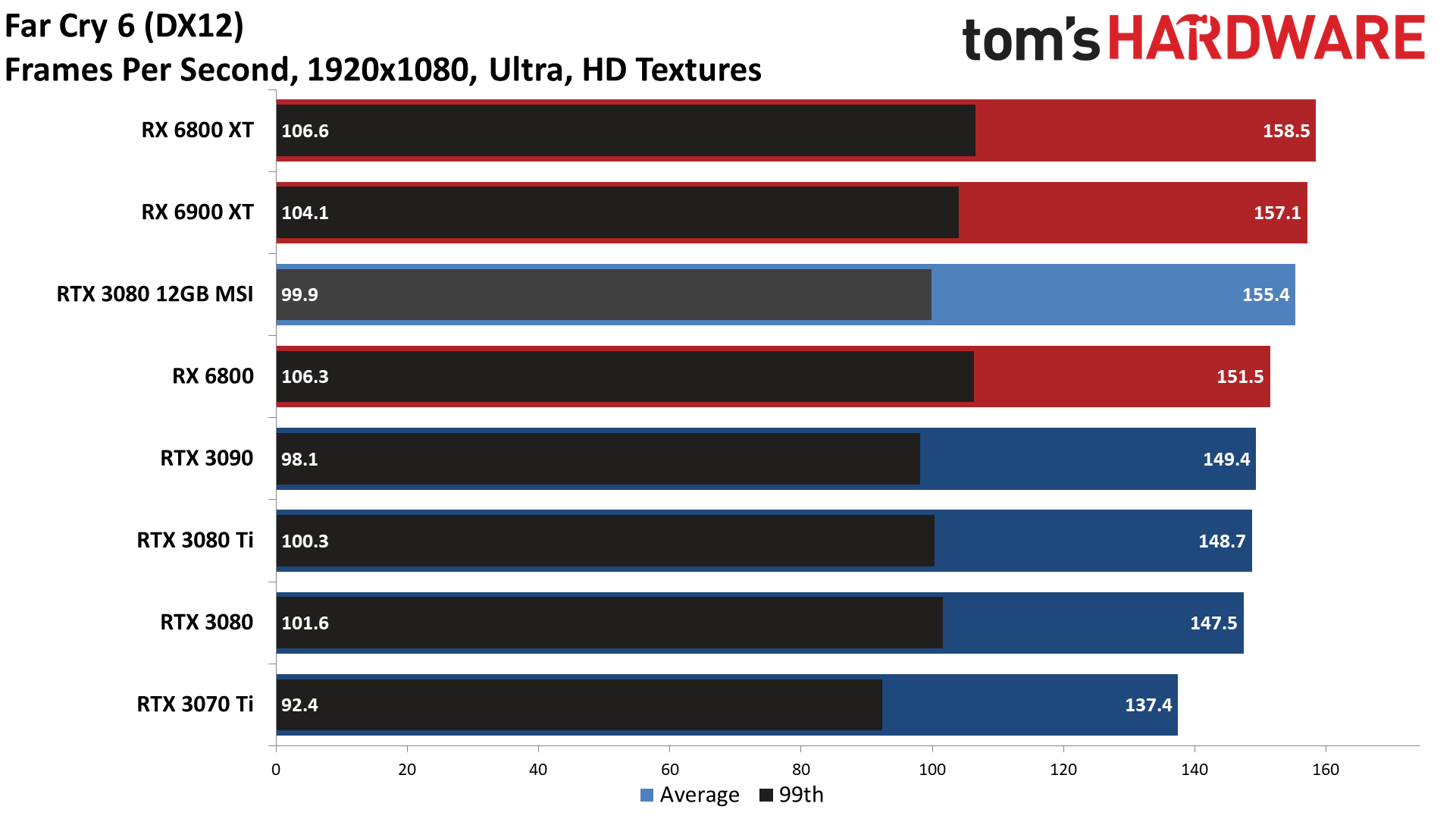





1080p DXR Ultra







While the MSI RTX 3080 12GB certainly isn't designed primarily for 1080p gaming, we'll start there. Overall, in our standard test suite, the MSI lands in the fourth spot, just behind the RTX 3090 and ahead of the RTX 3080 Ti. AMD's RX 6900 XT and 6800 XT claim the top two spots at this resolution, helped along by their large Infinity Cache.
Looking at the individual game results, there are a few cases where the RTX 3080 Ti comes out just ahead of the MSI card, and also a few instances where the MSI card beats even the 3090. The latter is likely thanks to the higher boost clocks, which affect not just the shader cores but also the render outputs and other elements of the GPU. Far Cry 6 is a good example of this, where the typical boost clock on the MSI card was 10–15% higher than on the other RTX cards. You can also see what DLSS can do for performance at 1080p, which isn't much. The three games that support DLSS only showed a 4–6% increase in framerates with Quality mode enabled.
Our standard suite is pretty heavy on AMD-promoted games, and only Red Dead Redemption 2 and Watch Dogs Legion gave the MSI card more than a tiny lead over AMD's RX 6800 XT, but that changes with our DXR (DirectX Raytracing) test suite. Overall, the MSI 3080 12GB was 42% faster than the RX 6900 XT and 54% faster than the 6800 XT, and that's without turning on DLSS. With DLSS Quality mode enabled, the MSI card was over twice as fast as the closest AMD GPU.
Somewhat surprisingly, Metro Exodus Enhanced seems to be the least demanding game in terms of using the ray tracing hardware on the various GPUs. The MSI card was only 17% faster than the RX 6900 XT in that game, while being 38–71% faster in the other five games. Minecraft meanwhile hit the RT cores the hardest, thanks to using full path tracing (that's what Nvidia calls it, anyway). If you want the overall average of all 13 games, MSI ended up beating the RX 6900 XT by 5%.
1440p Ultra





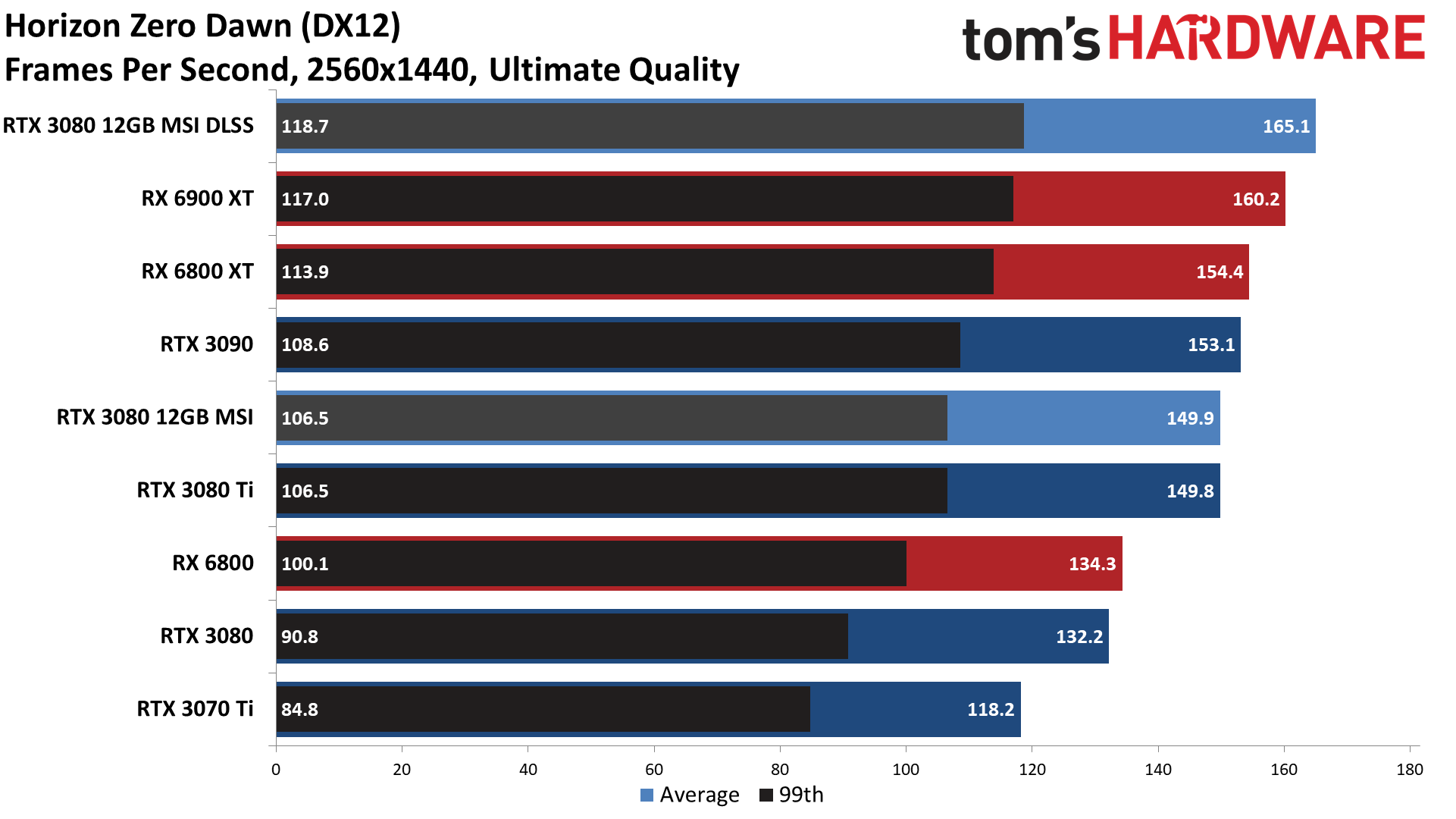
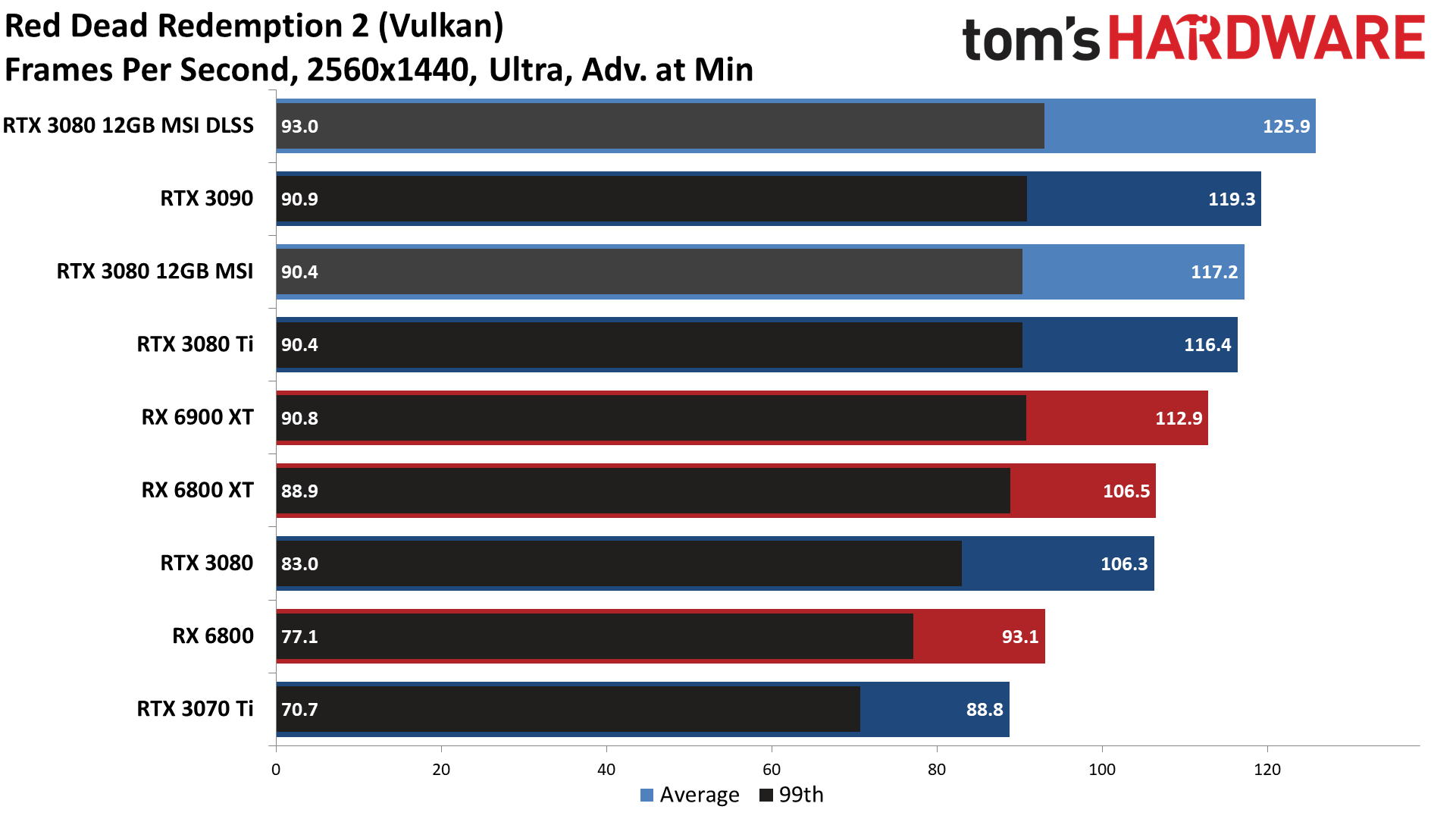

1440p DXR Ultra
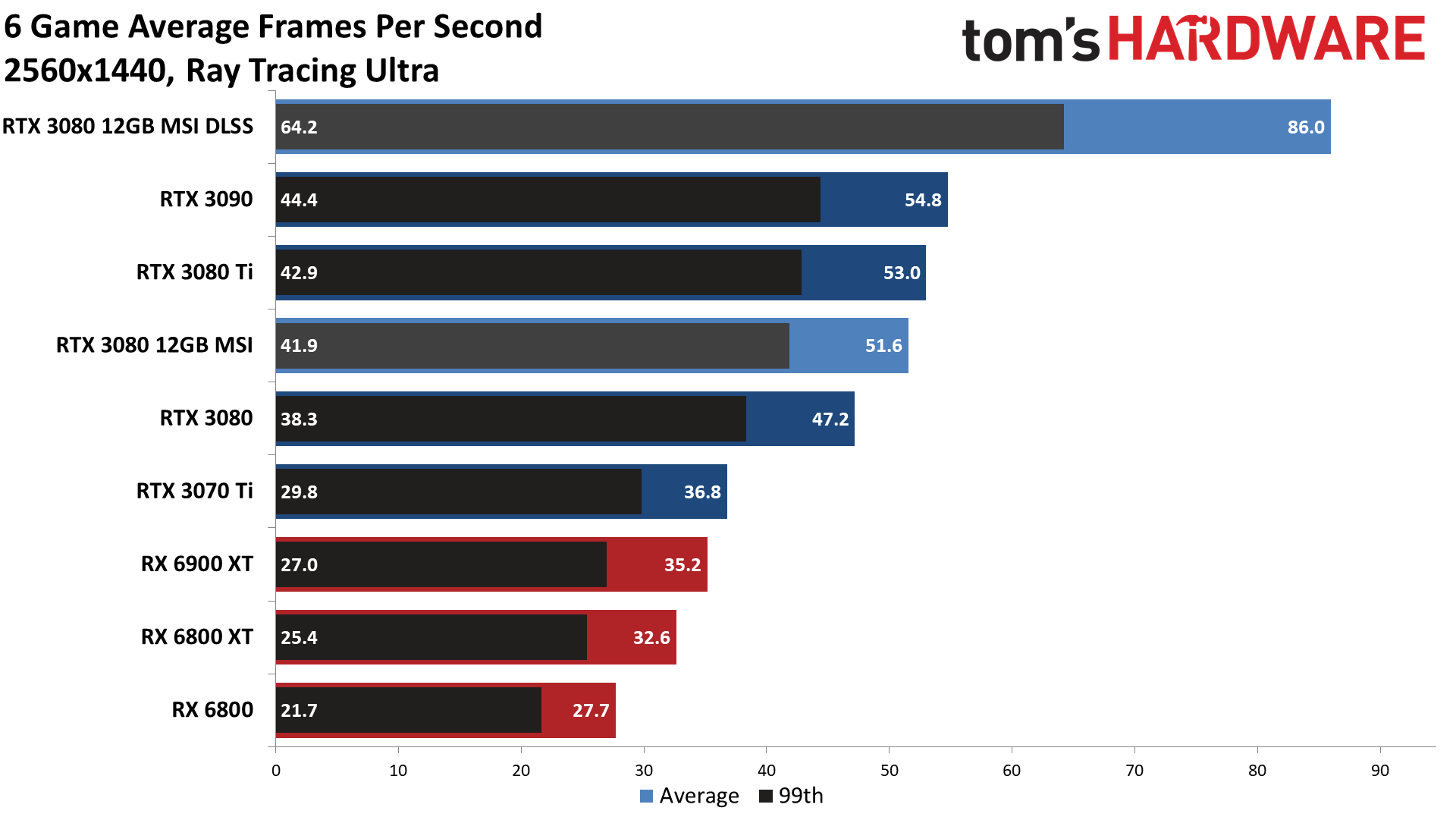
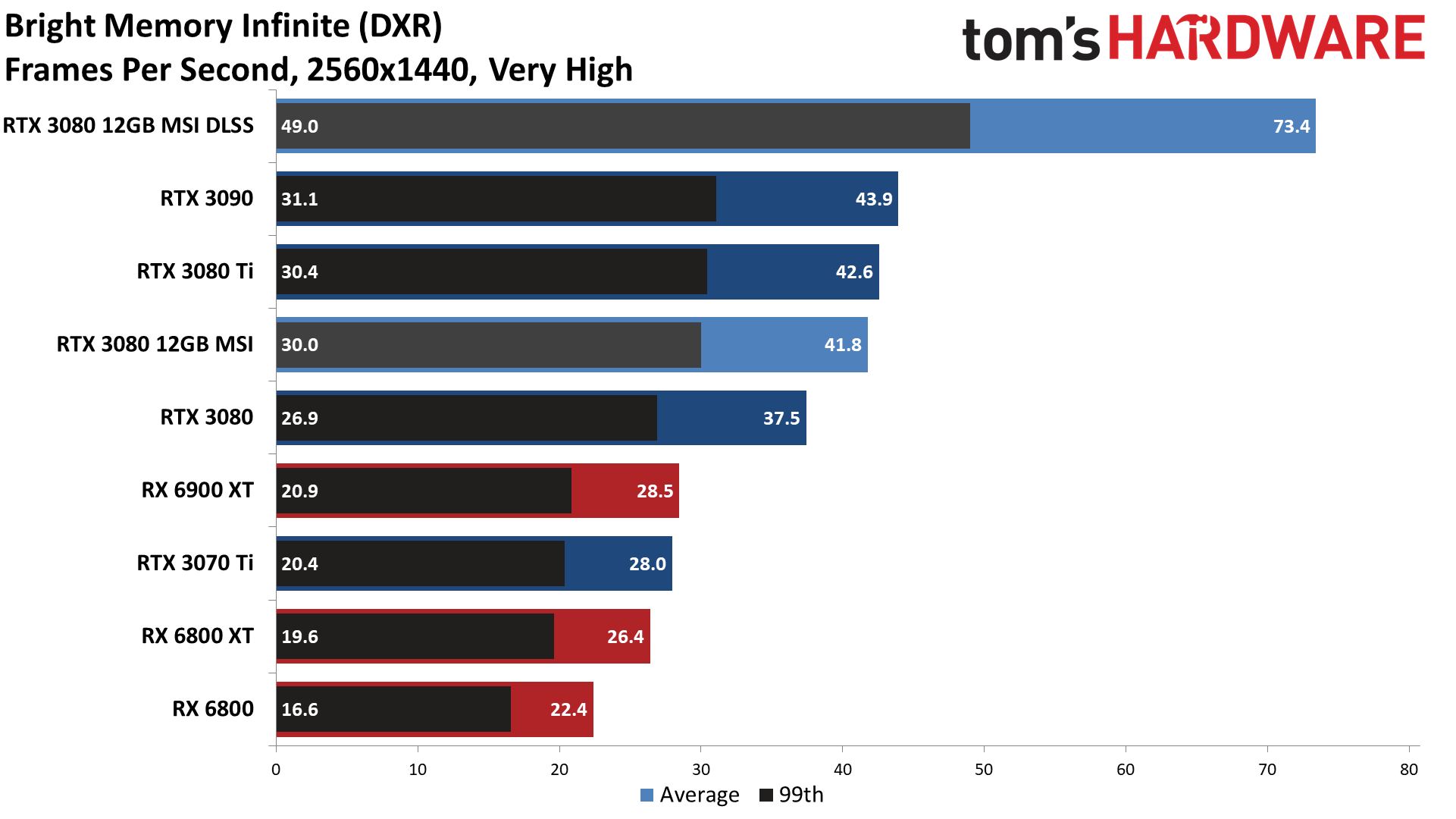

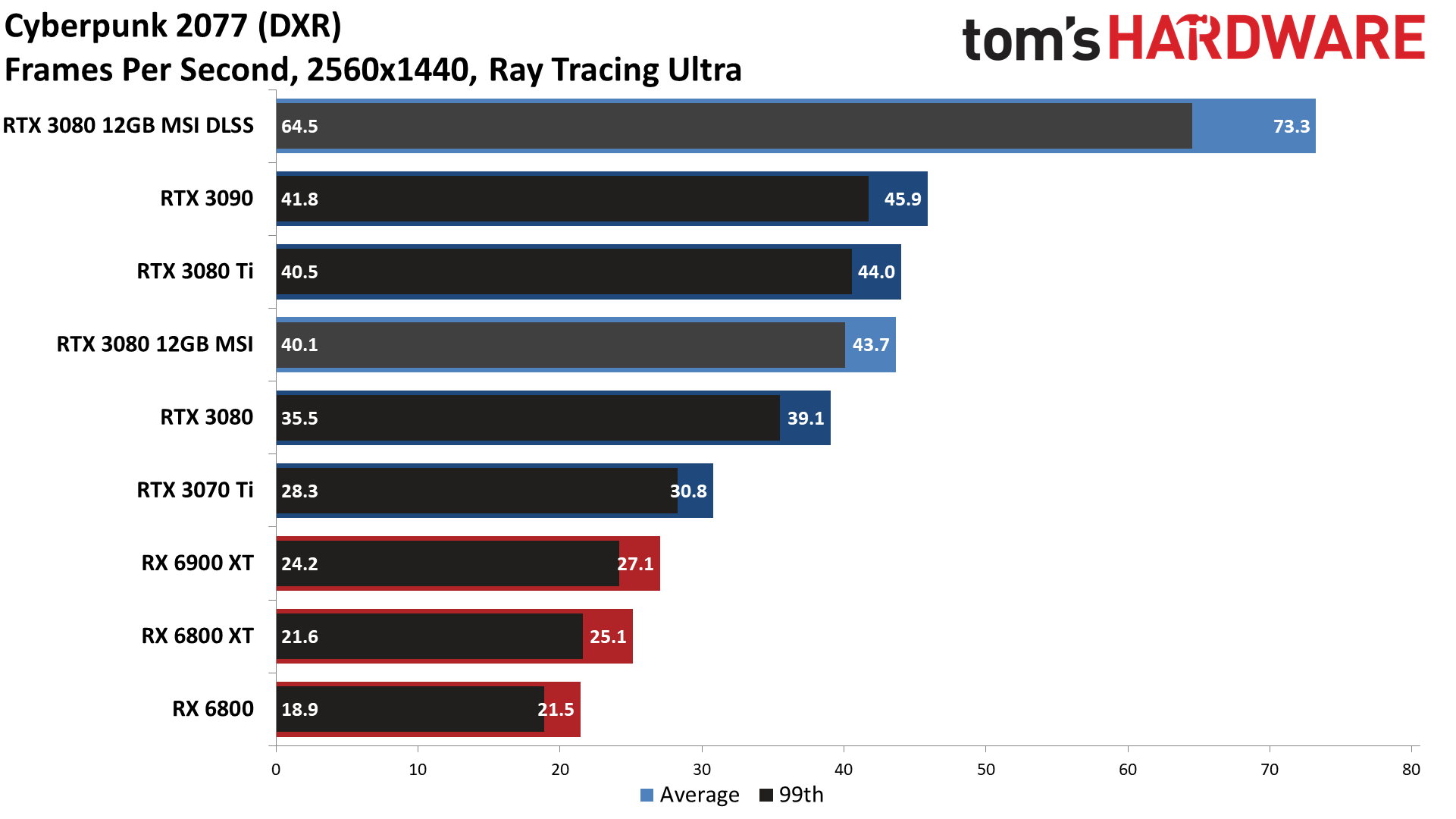



Bumping up the resolution to something more appropriate to the hardware, the MSI RTX 3080 12GB still managed to squeak past the 3080 Ti, and it was 9% faster than the 3080 10GB. AMD's RX 6900 XT still came out 6% ahead of MSI in the standard test suite, while the RX 6800 XT just edged past it by less than 1%. Basically, there was a 4-way tie for second place and most people wouldn't really notice the difference between the RTX 3090, RX 6800 XT, RTX 3080 Ti, and MSI RTX 3080 12GB in our non-RT gaming suite. There was more separation in the individual games, but it was the usual case of win some, lose some. DLSS Quality mode did help a bit more at 1440p at least, boosting performance by 7–20% in the three games that support it.
The DXR suite meanwhile favored Nvidia GPUs heavily. The original RTX 3080 10GB was 34% faster than the RX 6900 XT, and even the RTX 3070 Ti beat AMD's best by 5%. The MSI 3080 12GB meanwhile was 9% faster than the 3080 10GB, but this time the higher compute and RT power of the 3080 Ti and 3090 put those into the top two slots. DLSS with DXR was, as expected, far more beneficial than in non-DXR games, improving performance by 67% overall, with a range of 37–87%.
Combining all 13 games into a single average score, the MSI card was again 5% faster than the RX 6900 XT.
4K Ultra
Get Tom's Hardware's best news and in-depth reviews, straight to your inbox.



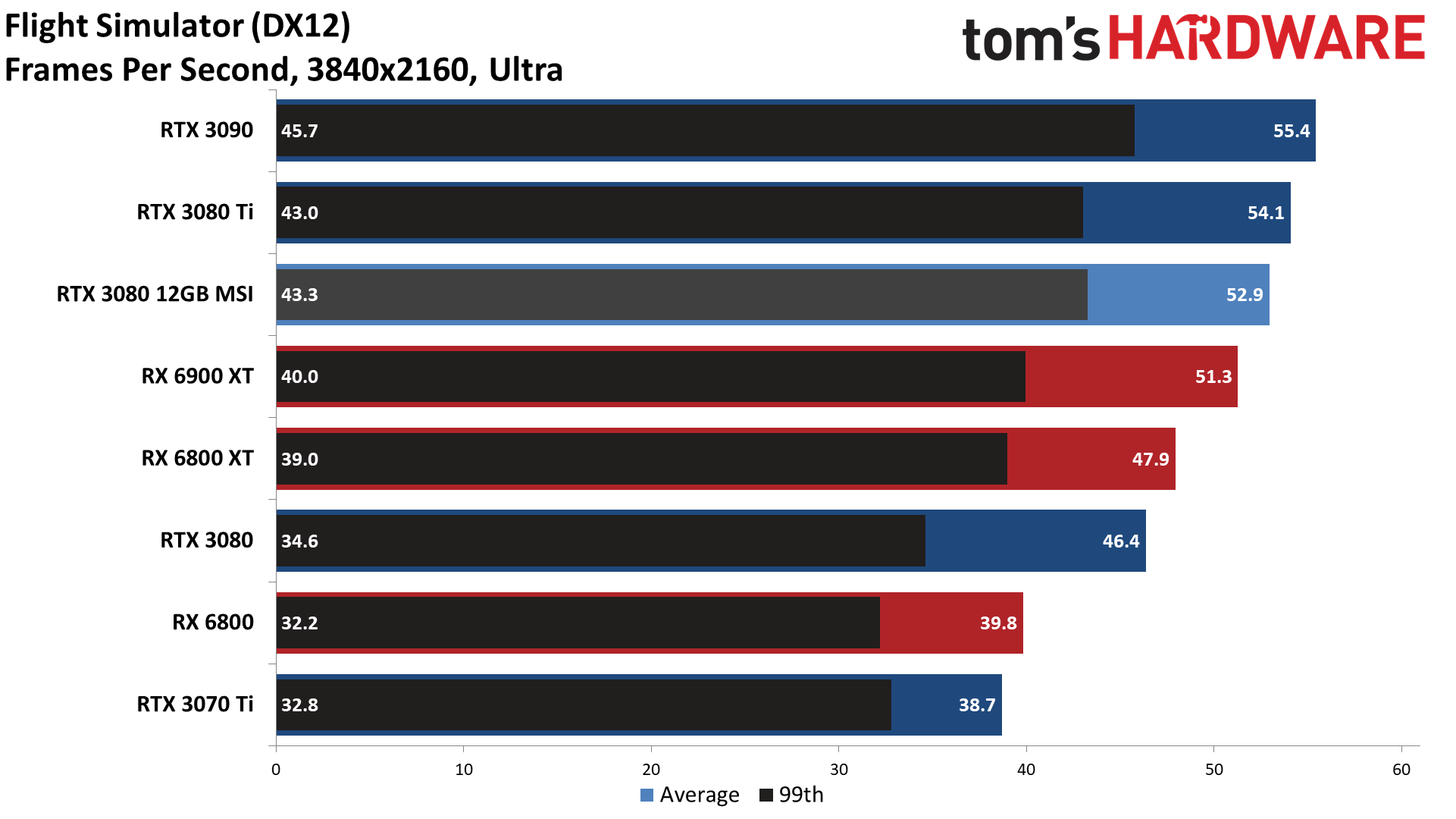




4K DXR Ultra

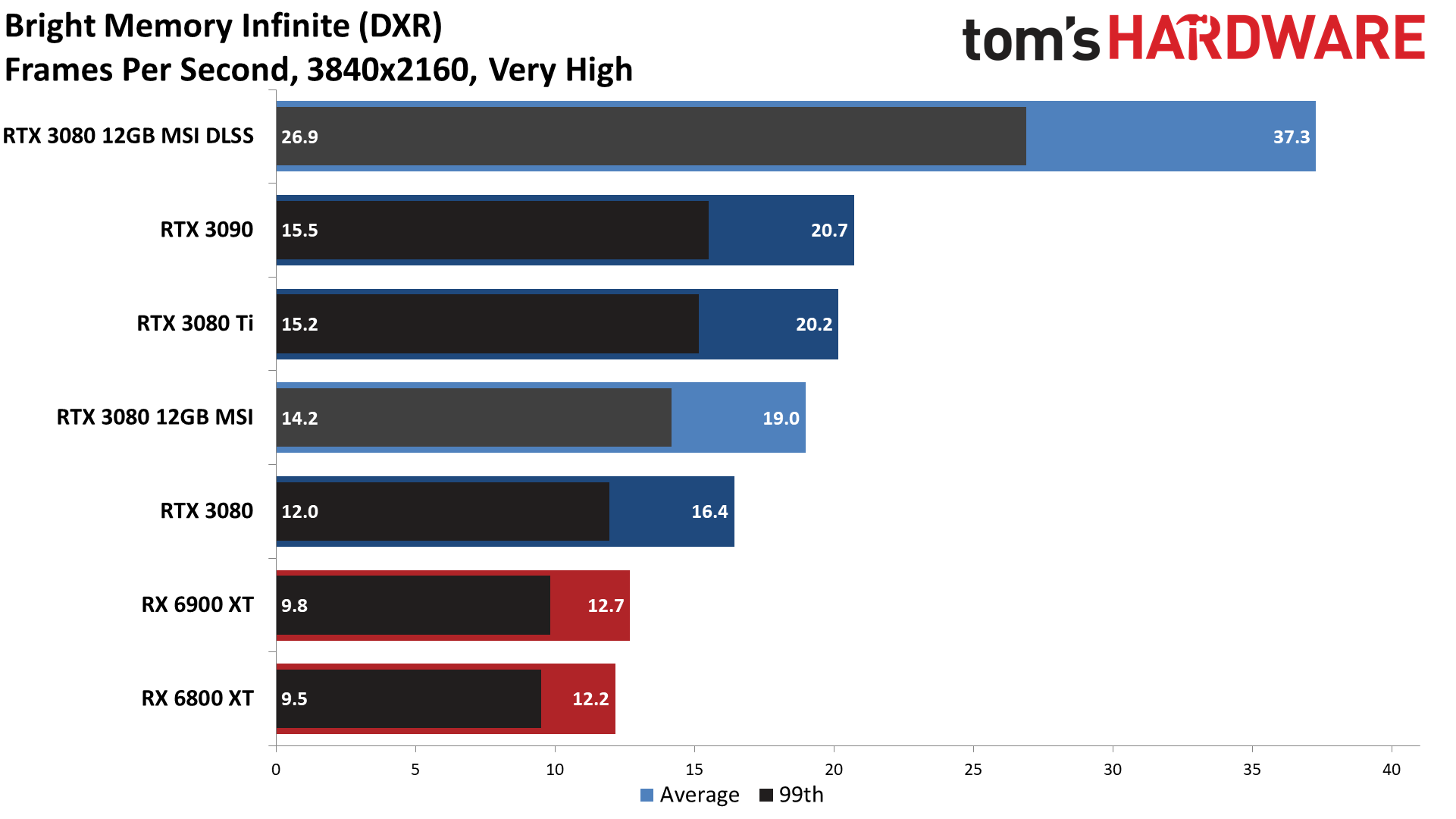


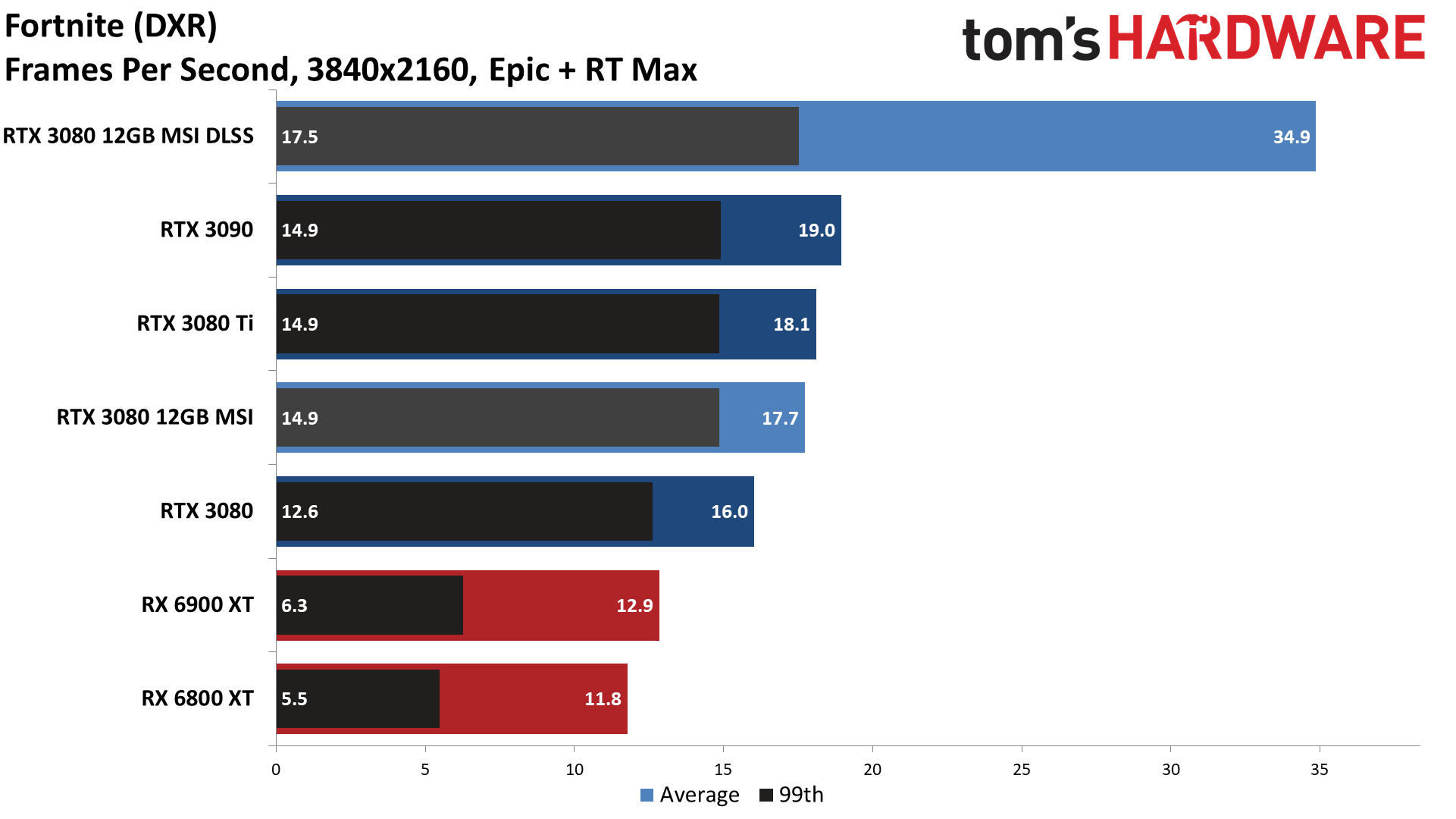


4K remains a difficult resolution for even the fastest GPUs, but six of the eight GPUs we tested averaged more than 60 fps across our standard test suite, and the MSI card tied the 3080 Ti and 6900 XT. The only game where none of the GPUs could break 60 fps at 4K was Flight Simulator, where the top GPUs averaged 50–55 frames per second.
Ray tracing is another matter entirely. Nvidia likes to promote DLSS in Performance mode, which upscales 1080p to 4K — and that's what Minecraft uses, since you can't specify which mode to use. That's not surprising, as not even the RTX 3090 could break 30 fps on average at native 4K ultra with DXR enabled. Turning on even DLSS Quality mode (in the five games where we can specify the mode) did nearly double the MSI card's performance this time, and you can get away with Balanced or even Performance modes at 4K since there's more data to work with for enhancing the pixels.
AMD's GPUs meanwhile can't come anywhere close to handling 4K at native resolution. Metro Exodus Enhanced was the best-case result (though we didn't enable HairWorks or Enhanced PhysX), and still only managed framerates in the mid to high 20s. Overall, looking at the performance of all 13 games, the MSI card beat the 6900 XT by 8% at 4K. If we give equal weight to every test, incidentally (using the geometric mean), the MSI RTX 3080 12GB was 16% faster than the RX 6900 XT.
- MORE: Best Graphics Cards
- MORE: GPU Benchmarks and Hierarchy
- MORE: All Graphics Content
Current page: MSI GeForce RTX 3080 12GB Gaming Performance
Prev Page MSI GeForce RTX 3080 12GB Suprim X Next Page MSI GeForce RTX 3080 12GB Power, Temps, Noise, Etc.
Jarred Walton is a senior editor at Tom's Hardware focusing on everything GPU. He has been working as a tech journalist since 2004, writing for AnandTech, Maximum PC, and PC Gamer. From the first S3 Virge '3D decelerators' to today's GPUs, Jarred keeps up with all the latest graphics trends and is the one to ask about game performance.
-
King_V Reply"You know, we have a lot of GA102 chips where all 12 memory controllers are perfectly fine but where we can't hit the necessary 80 SMs for the 3080 Ti. Rather than selling these as an RTX 3080 10GB, what if we just make a 3080 12GB? Then we don't have to directly deal with the supposed $699 MSRP."
That may not be exactly what happened, but it certainly feels that way. MSI has produced a graphics card that effectively ties the RTX 3080 Ti in performance, even though it has 10 fewer SMs and needs more power to get there.
I guess that's one way to hit the price point and raw performance metrics. -
10tacle THANK YOU Jared for including FS2020 in this hardware review! That's pretty much all I use my rig for as a hard core flight simmer. I find the gap increase at 4K with the 3080 Ti (my GPU) over this 10GB 3080 interesting. That sim is a strange hardware demand duck and I'm still trying to figure out fine tuning details some 6 months on now since my build last August after winning a NewEgg shuffle to get the GPU (I paid $1399.99 for the EVGA FTW3 edition).Reply
The interesting thing is that it is the only game (sim to me) that shows a leg stretch gap between the lower tiered/VRAM'd cards, including this 10GB 3080, at 4K. My guess is that's where the Ti's wider memory bus bandwidth, CUDA cores (I still call Nvidia GPU cores that), and extra 2GB VRAM come together to show off the power of the GPU. The same can be said with the 3090 sitting at the top of the FS2020 chart at 4K. -
HideOut I hope the Intel ARC series is competitive and they put so much price pressure on nVidia that they nearly go broke. They're doing noithing but ripping off customers these days with this kinda rediculous trash.Reply -
watzupken I actually see no point in paying this much for a RTX 3000 series card when we are expecting RDNA3 and RTX 4000 series to be announced later this year. I feel Nvidia released this card with the intention of increasing prices, less to push performance. After all, between RTX 3080 and RTX 3090, each "new" product is just marginally better than the previous, but cost quite a bit more for a few % improvement.Reply -
JarredWaltonGPU Reply
Like I said in the review, Nvidia claims this was an AIB-driven release. Meaning, MSI, Asus, EVGA, Gigabyte, etc. wanted an alternative to the 3080 Ti and 3080 10GB. Probably there were chips that could be used in the "formerly Quadro" line that have similar specs of 70 SMs and 384-bit memory interface, and Nvidia created this SKU for them to use. But that would assume there's less demand for the professional GPUs right now, as otherwise Nvidia would presumably prefer selling the chips in that more lucrative market.watzupken said:I actually see no point in paying this much for a RTX 3000 series card when we are expecting RDNA3 and RTX 4000 series to be announced later this year. I feel Nvidia released this card with the intention of increasing prices, less to push performance. After all, between RTX 3080 and RTX 3090, each "new" product is just marginally better than the previous, but cost quite a bit more for a few % improvement.